Management-Knowledge and Information Management
VerifiedAdded on 2023/03/23
|12
|3085
|55
AI Summary
This article discusses the importance of ontologies in knowledge management, the advantages and limitations of using ontologies, and the role of information retrieval in knowledge management.
Contribute Materials
Your contribution can guide someone’s learning journey. Share your
documents today.
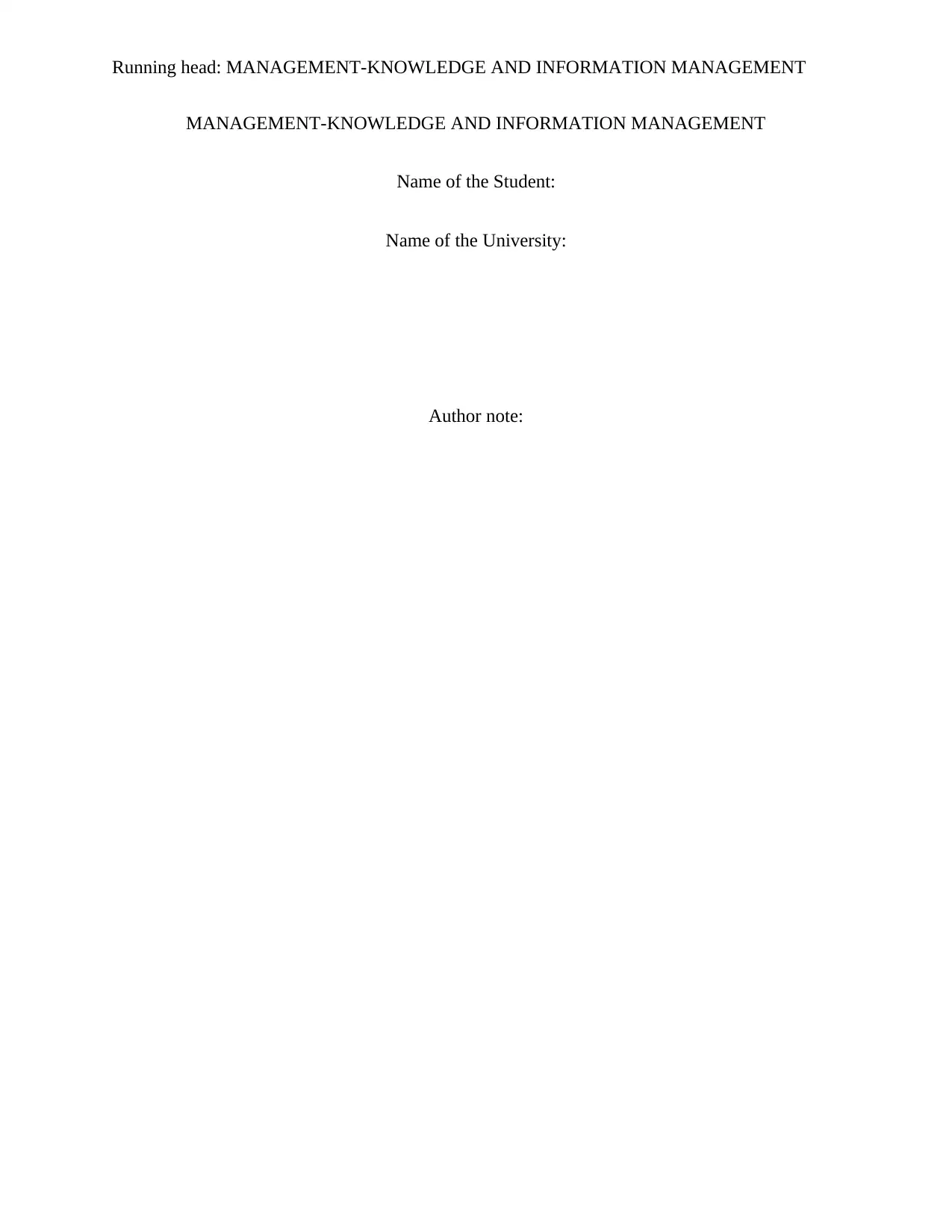
Running head: MANAGEMENT-KNOWLEDGE AND INFORMATION MANAGEMENT
MANAGEMENT-KNOWLEDGE AND INFORMATION MANAGEMENT
Name of the Student:
Name of the University:
Author note:
MANAGEMENT-KNOWLEDGE AND INFORMATION MANAGEMENT
Name of the Student:
Name of the University:
Author note:
Secure Best Marks with AI Grader
Need help grading? Try our AI Grader for instant feedback on your assignments.
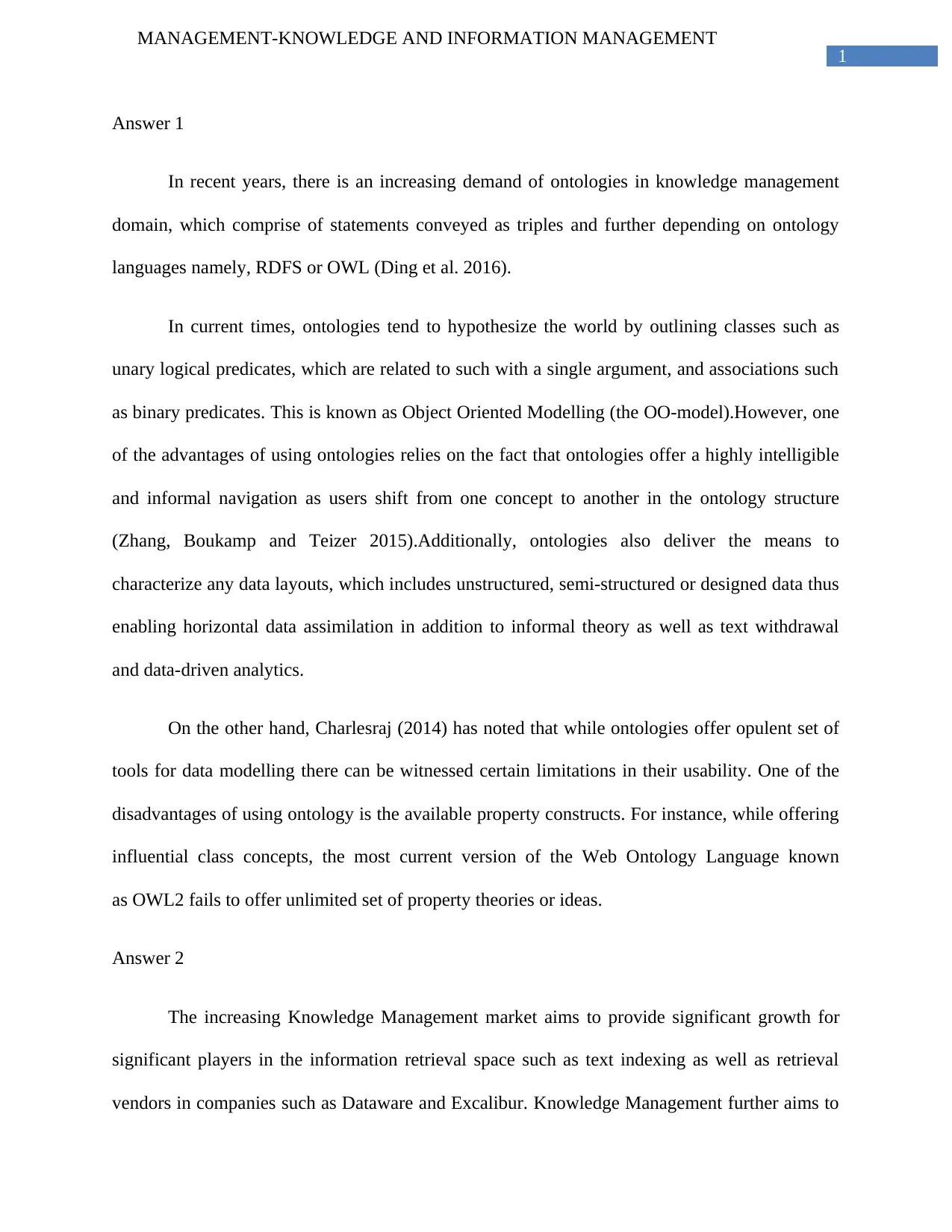
1
MANAGEMENT-KNOWLEDGE AND INFORMATION MANAGEMENT
Answer 1
In recent years, there is an increasing demand of ontologies in knowledge management
domain, which comprise of statements conveyed as triples and further depending on ontology
languages namely, RDFS or OWL (Ding et al. 2016).
In current times, ontologies tend to hypothesize the world by outlining classes such as
unary logical predicates, which are related to such with a single argument, and associations such
as binary predicates. This is known as Object Oriented Modelling (the OO-model).However, one
of the advantages of using ontologies relies on the fact that ontologies offer a highly intelligible
and informal navigation as users shift from one concept to another in the ontology structure
(Zhang, Boukamp and Teizer 2015).Additionally, ontologies also deliver the means to
characterize any data layouts, which includes unstructured, semi-structured or designed data thus
enabling horizontal data assimilation in addition to informal theory as well as text withdrawal
and data-driven analytics.
On the other hand, Charlesraj (2014) has noted that while ontologies offer opulent set of
tools for data modelling there can be witnessed certain limitations in their usability. One of the
disadvantages of using ontology is the available property constructs. For instance, while offering
influential class concepts, the most current version of the Web Ontology Language known
as OWL2 fails to offer unlimited set of property theories or ideas.
Answer 2
The increasing Knowledge Management market aims to provide significant growth for
significant players in the information retrieval space such as text indexing as well as retrieval
vendors in companies such as Dataware and Excalibur. Knowledge Management further aims to
MANAGEMENT-KNOWLEDGE AND INFORMATION MANAGEMENT
Answer 1
In recent years, there is an increasing demand of ontologies in knowledge management
domain, which comprise of statements conveyed as triples and further depending on ontology
languages namely, RDFS or OWL (Ding et al. 2016).
In current times, ontologies tend to hypothesize the world by outlining classes such as
unary logical predicates, which are related to such with a single argument, and associations such
as binary predicates. This is known as Object Oriented Modelling (the OO-model).However, one
of the advantages of using ontologies relies on the fact that ontologies offer a highly intelligible
and informal navigation as users shift from one concept to another in the ontology structure
(Zhang, Boukamp and Teizer 2015).Additionally, ontologies also deliver the means to
characterize any data layouts, which includes unstructured, semi-structured or designed data thus
enabling horizontal data assimilation in addition to informal theory as well as text withdrawal
and data-driven analytics.
On the other hand, Charlesraj (2014) has noted that while ontologies offer opulent set of
tools for data modelling there can be witnessed certain limitations in their usability. One of the
disadvantages of using ontology is the available property constructs. For instance, while offering
influential class concepts, the most current version of the Web Ontology Language known
as OWL2 fails to offer unlimited set of property theories or ideas.
Answer 2
The increasing Knowledge Management market aims to provide significant growth for
significant players in the information retrieval space such as text indexing as well as retrieval
vendors in companies such as Dataware and Excalibur. Knowledge Management further aims to

2
MANAGEMENT-KNOWLEDGE AND INFORMATION MANAGEMENT
offer significant prospects for new search technology of Microsoft bundled in Site Server.
Moreover, reports of Girard and Girard (2015) have revealed that admission of Microsoft into
the searching and Knowledge Management space aids legitimizing the value as well as market
potential of information retrieval. The information most organizations use is located in a variety
of different data stores. Reports of Pärn, Edwards and Sing (2017), those valuable origins tend to
comprise of file servers, groupware systems, relational databases, legacy systems as well as even
external sources such as the Web. One of the advantages of information retrieval is that through
such retrieval system, companies will be able to "capture" information in any location and give
users access to it. Furthermore, the value of the information gains transparency as organizations
begin to transfer text retrieval from a departmental placement to an enterprise disposition. In
addition to this, as information retrieval systems develops, such a process has been efficiently
incorporating innovative features that aim to highlight other areas of Knowledge Management.
Girard and Girard (2015) have noted that information retrieval is not only restricted to searching
but has been addressing areas related to information delivery thus facilitating users discover
proficiency instead of only data. Furthermore, it aids organizations acquire knowledge from the
categories of demands that are being defer to by users.
On the other hand, Pärn, Edwards and Sing (2017) have highlighted practical study of
keyword search limitations. Even though, keywords serve a highly decisive role in information
retrieval, they show critical disadvantages.
Answer 3
Intellectual property management, knowledge management are disciplines which have
been treated independently in the organizational domain. Baldwin and Henkel (2015) have noted
MANAGEMENT-KNOWLEDGE AND INFORMATION MANAGEMENT
offer significant prospects for new search technology of Microsoft bundled in Site Server.
Moreover, reports of Girard and Girard (2015) have revealed that admission of Microsoft into
the searching and Knowledge Management space aids legitimizing the value as well as market
potential of information retrieval. The information most organizations use is located in a variety
of different data stores. Reports of Pärn, Edwards and Sing (2017), those valuable origins tend to
comprise of file servers, groupware systems, relational databases, legacy systems as well as even
external sources such as the Web. One of the advantages of information retrieval is that through
such retrieval system, companies will be able to "capture" information in any location and give
users access to it. Furthermore, the value of the information gains transparency as organizations
begin to transfer text retrieval from a departmental placement to an enterprise disposition. In
addition to this, as information retrieval systems develops, such a process has been efficiently
incorporating innovative features that aim to highlight other areas of Knowledge Management.
Girard and Girard (2015) have noted that information retrieval is not only restricted to searching
but has been addressing areas related to information delivery thus facilitating users discover
proficiency instead of only data. Furthermore, it aids organizations acquire knowledge from the
categories of demands that are being defer to by users.
On the other hand, Pärn, Edwards and Sing (2017) have highlighted practical study of
keyword search limitations. Even though, keywords serve a highly decisive role in information
retrieval, they show critical disadvantages.
Answer 3
Intellectual property management, knowledge management are disciplines which have
been treated independently in the organizational domain. Baldwin and Henkel (2015) have noted
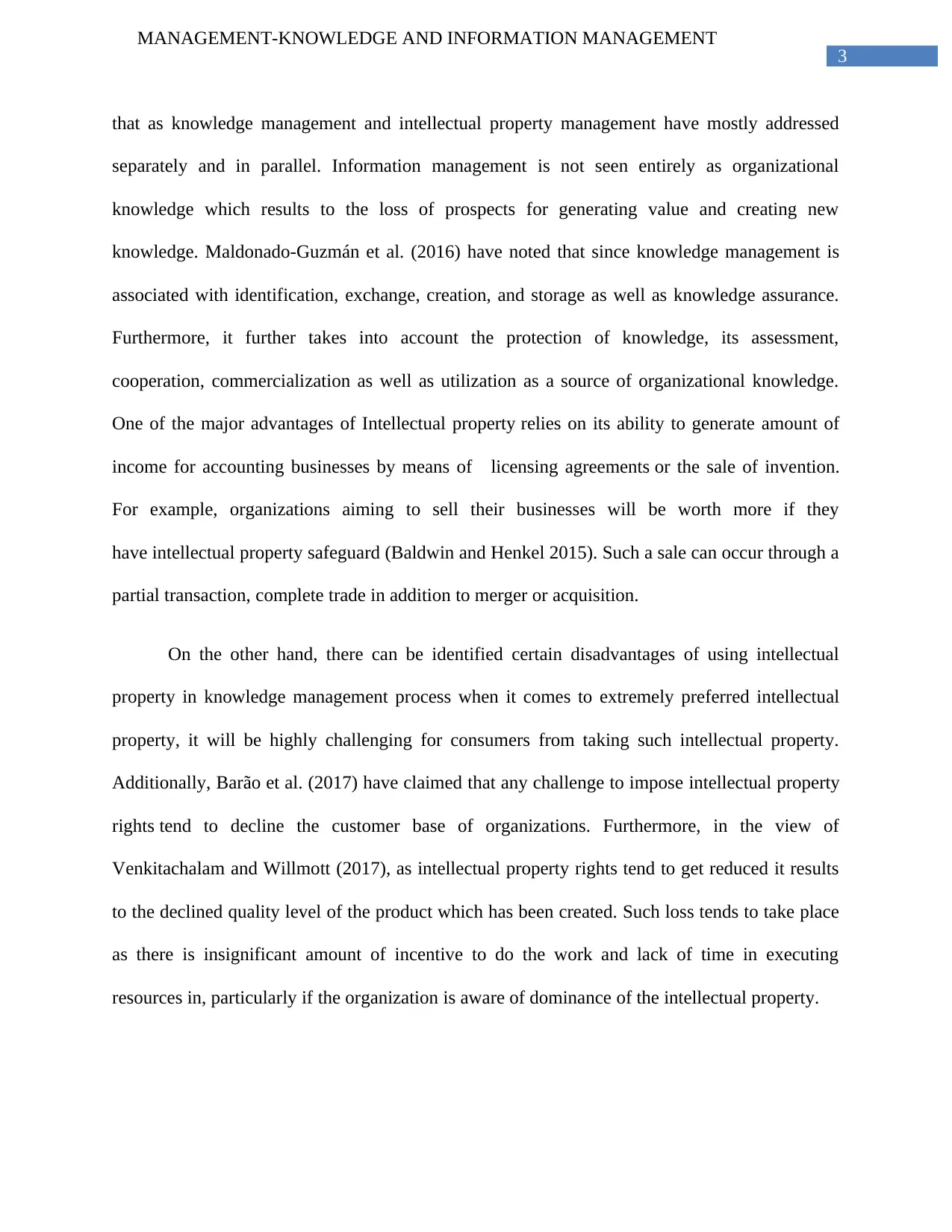
3
MANAGEMENT-KNOWLEDGE AND INFORMATION MANAGEMENT
that as knowledge management and intellectual property management have mostly addressed
separately and in parallel. Information management is not seen entirely as organizational
knowledge which results to the loss of prospects for generating value and creating new
knowledge. Maldonado-Guzmán et al. (2016) have noted that since knowledge management is
associated with identification, exchange, creation, and storage as well as knowledge assurance.
Furthermore, it further takes into account the protection of knowledge, its assessment,
cooperation, commercialization as well as utilization as a source of organizational knowledge.
One of the major advantages of Intellectual property relies on its ability to generate amount of
income for accounting businesses by means of licensing agreements or the sale of invention.
For example, organizations aiming to sell their businesses will be worth more if they
have intellectual property safeguard (Baldwin and Henkel 2015). Such a sale can occur through a
partial transaction, complete trade in addition to merger or acquisition.
On the other hand, there can be identified certain disadvantages of using intellectual
property in knowledge management process when it comes to extremely preferred intellectual
property, it will be highly challenging for consumers from taking such intellectual property.
Additionally, Barão et al. (2017) have claimed that any challenge to impose intellectual property
rights tend to decline the customer base of organizations. Furthermore, in the view of
Venkitachalam and Willmott (2017), as intellectual property rights tend to get reduced it results
to the declined quality level of the product which has been created. Such loss tends to take place
as there is insignificant amount of incentive to do the work and lack of time in executing
resources in, particularly if the organization is aware of dominance of the intellectual property.
MANAGEMENT-KNOWLEDGE AND INFORMATION MANAGEMENT
that as knowledge management and intellectual property management have mostly addressed
separately and in parallel. Information management is not seen entirely as organizational
knowledge which results to the loss of prospects for generating value and creating new
knowledge. Maldonado-Guzmán et al. (2016) have noted that since knowledge management is
associated with identification, exchange, creation, and storage as well as knowledge assurance.
Furthermore, it further takes into account the protection of knowledge, its assessment,
cooperation, commercialization as well as utilization as a source of organizational knowledge.
One of the major advantages of Intellectual property relies on its ability to generate amount of
income for accounting businesses by means of licensing agreements or the sale of invention.
For example, organizations aiming to sell their businesses will be worth more if they
have intellectual property safeguard (Baldwin and Henkel 2015). Such a sale can occur through a
partial transaction, complete trade in addition to merger or acquisition.
On the other hand, there can be identified certain disadvantages of using intellectual
property in knowledge management process when it comes to extremely preferred intellectual
property, it will be highly challenging for consumers from taking such intellectual property.
Additionally, Barão et al. (2017) have claimed that any challenge to impose intellectual property
rights tend to decline the customer base of organizations. Furthermore, in the view of
Venkitachalam and Willmott (2017), as intellectual property rights tend to get reduced it results
to the declined quality level of the product which has been created. Such loss tends to take place
as there is insignificant amount of incentive to do the work and lack of time in executing
resources in, particularly if the organization is aware of dominance of the intellectual property.
Secure Best Marks with AI Grader
Need help grading? Try our AI Grader for instant feedback on your assignments.
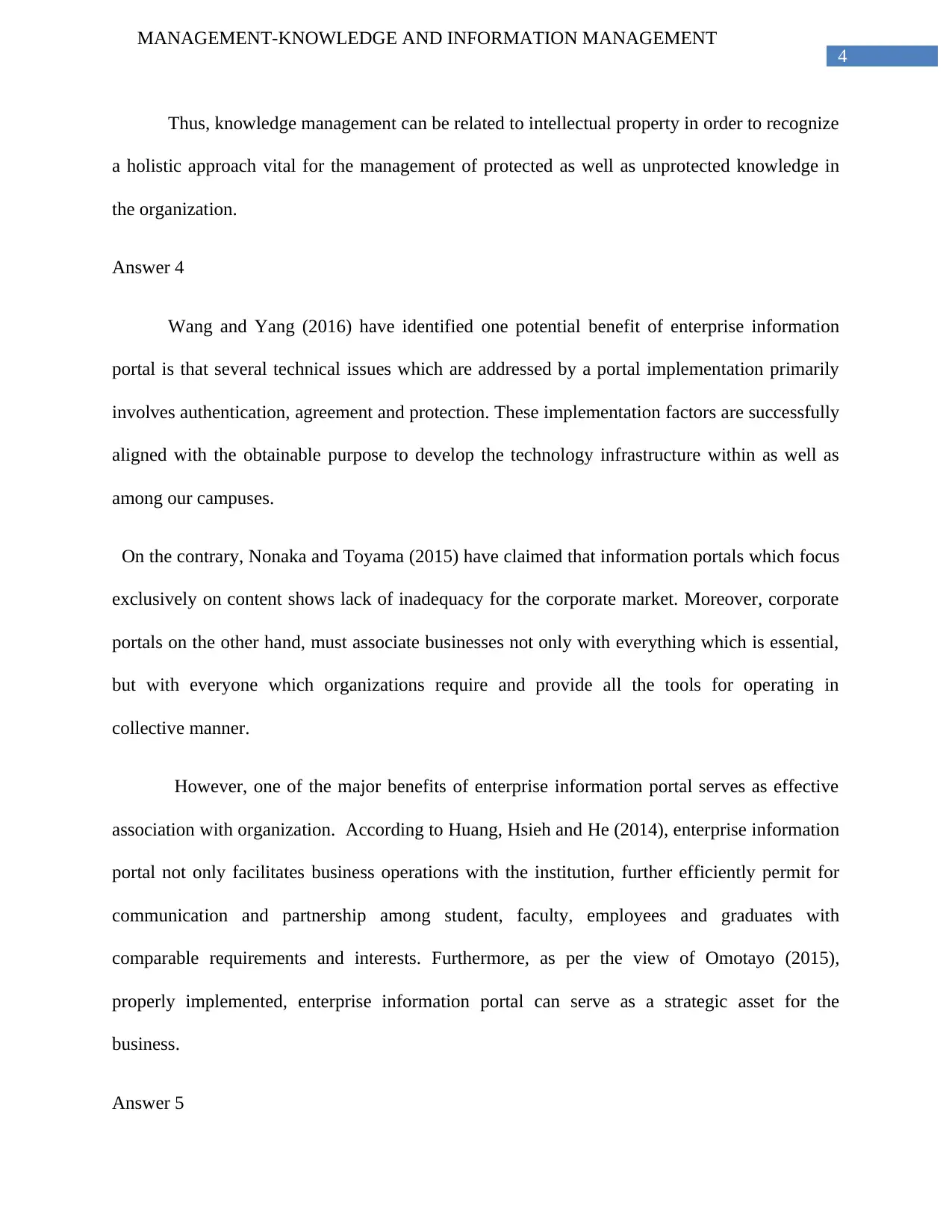
4
MANAGEMENT-KNOWLEDGE AND INFORMATION MANAGEMENT
Thus, knowledge management can be related to intellectual property in order to recognize
a holistic approach vital for the management of protected as well as unprotected knowledge in
the organization.
Answer 4
Wang and Yang (2016) have identified one potential benefit of enterprise information
portal is that several technical issues which are addressed by a portal implementation primarily
involves authentication, agreement and protection. These implementation factors are successfully
aligned with the obtainable purpose to develop the technology infrastructure within as well as
among our campuses.
On the contrary, Nonaka and Toyama (2015) have claimed that information portals which focus
exclusively on content shows lack of inadequacy for the corporate market. Moreover, corporate
portals on the other hand, must associate businesses not only with everything which is essential,
but with everyone which organizations require and provide all the tools for operating in
collective manner.
However, one of the major benefits of enterprise information portal serves as effective
association with organization. According to Huang, Hsieh and He (2014), enterprise information
portal not only facilitates business operations with the institution, further efficiently permit for
communication and partnership among student, faculty, employees and graduates with
comparable requirements and interests. Furthermore, as per the view of Omotayo (2015),
properly implemented, enterprise information portal can serve as a strategic asset for the
business.
Answer 5
MANAGEMENT-KNOWLEDGE AND INFORMATION MANAGEMENT
Thus, knowledge management can be related to intellectual property in order to recognize
a holistic approach vital for the management of protected as well as unprotected knowledge in
the organization.
Answer 4
Wang and Yang (2016) have identified one potential benefit of enterprise information
portal is that several technical issues which are addressed by a portal implementation primarily
involves authentication, agreement and protection. These implementation factors are successfully
aligned with the obtainable purpose to develop the technology infrastructure within as well as
among our campuses.
On the contrary, Nonaka and Toyama (2015) have claimed that information portals which focus
exclusively on content shows lack of inadequacy for the corporate market. Moreover, corporate
portals on the other hand, must associate businesses not only with everything which is essential,
but with everyone which organizations require and provide all the tools for operating in
collective manner.
However, one of the major benefits of enterprise information portal serves as effective
association with organization. According to Huang, Hsieh and He (2014), enterprise information
portal not only facilitates business operations with the institution, further efficiently permit for
communication and partnership among student, faculty, employees and graduates with
comparable requirements and interests. Furthermore, as per the view of Omotayo (2015),
properly implemented, enterprise information portal can serve as a strategic asset for the
business.
Answer 5
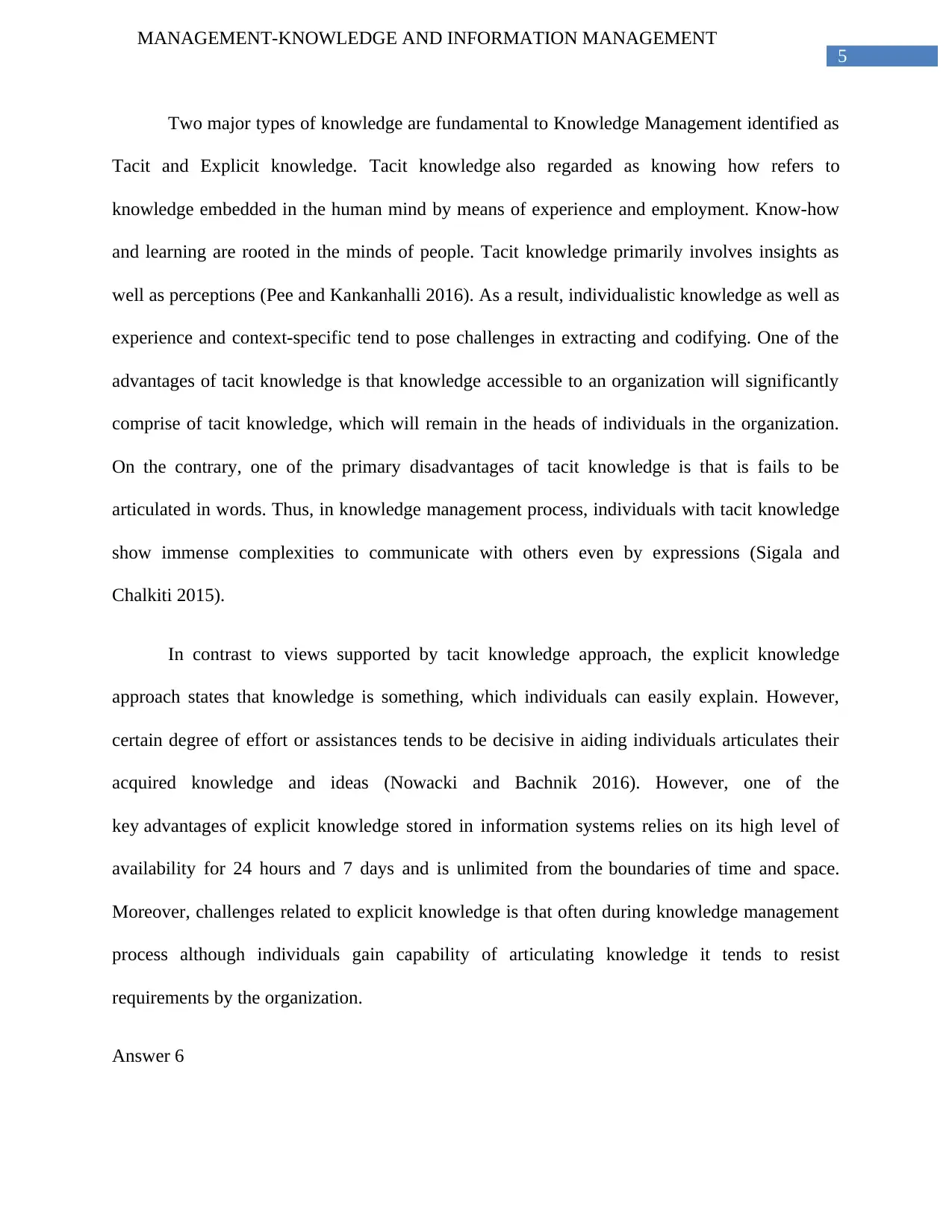
5
MANAGEMENT-KNOWLEDGE AND INFORMATION MANAGEMENT
Two major types of knowledge are fundamental to Knowledge Management identified as
Tacit and Explicit knowledge. Tacit knowledge also regarded as knowing how refers to
knowledge embedded in the human mind by means of experience and employment. Know-how
and learning are rooted in the minds of people. Tacit knowledge primarily involves insights as
well as perceptions (Pee and Kankanhalli 2016). As a result, individualistic knowledge as well as
experience and context-specific tend to pose challenges in extracting and codifying. One of the
advantages of tacit knowledge is that knowledge accessible to an organization will significantly
comprise of tacit knowledge, which will remain in the heads of individuals in the organization.
On the contrary, one of the primary disadvantages of tacit knowledge is that is fails to be
articulated in words. Thus, in knowledge management process, individuals with tacit knowledge
show immense complexities to communicate with others even by expressions (Sigala and
Chalkiti 2015).
In contrast to views supported by tacit knowledge approach, the explicit knowledge
approach states that knowledge is something, which individuals can easily explain. However,
certain degree of effort or assistances tends to be decisive in aiding individuals articulates their
acquired knowledge and ideas (Nowacki and Bachnik 2016). However, one of the
key advantages of explicit knowledge stored in information systems relies on its high level of
availability for 24 hours and 7 days and is unlimited from the boundaries of time and space.
Moreover, challenges related to explicit knowledge is that often during knowledge management
process although individuals gain capability of articulating knowledge it tends to resist
requirements by the organization.
Answer 6
MANAGEMENT-KNOWLEDGE AND INFORMATION MANAGEMENT
Two major types of knowledge are fundamental to Knowledge Management identified as
Tacit and Explicit knowledge. Tacit knowledge also regarded as knowing how refers to
knowledge embedded in the human mind by means of experience and employment. Know-how
and learning are rooted in the minds of people. Tacit knowledge primarily involves insights as
well as perceptions (Pee and Kankanhalli 2016). As a result, individualistic knowledge as well as
experience and context-specific tend to pose challenges in extracting and codifying. One of the
advantages of tacit knowledge is that knowledge accessible to an organization will significantly
comprise of tacit knowledge, which will remain in the heads of individuals in the organization.
On the contrary, one of the primary disadvantages of tacit knowledge is that is fails to be
articulated in words. Thus, in knowledge management process, individuals with tacit knowledge
show immense complexities to communicate with others even by expressions (Sigala and
Chalkiti 2015).
In contrast to views supported by tacit knowledge approach, the explicit knowledge
approach states that knowledge is something, which individuals can easily explain. However,
certain degree of effort or assistances tends to be decisive in aiding individuals articulates their
acquired knowledge and ideas (Nowacki and Bachnik 2016). However, one of the
key advantages of explicit knowledge stored in information systems relies on its high level of
availability for 24 hours and 7 days and is unlimited from the boundaries of time and space.
Moreover, challenges related to explicit knowledge is that often during knowledge management
process although individuals gain capability of articulating knowledge it tends to resist
requirements by the organization.
Answer 6
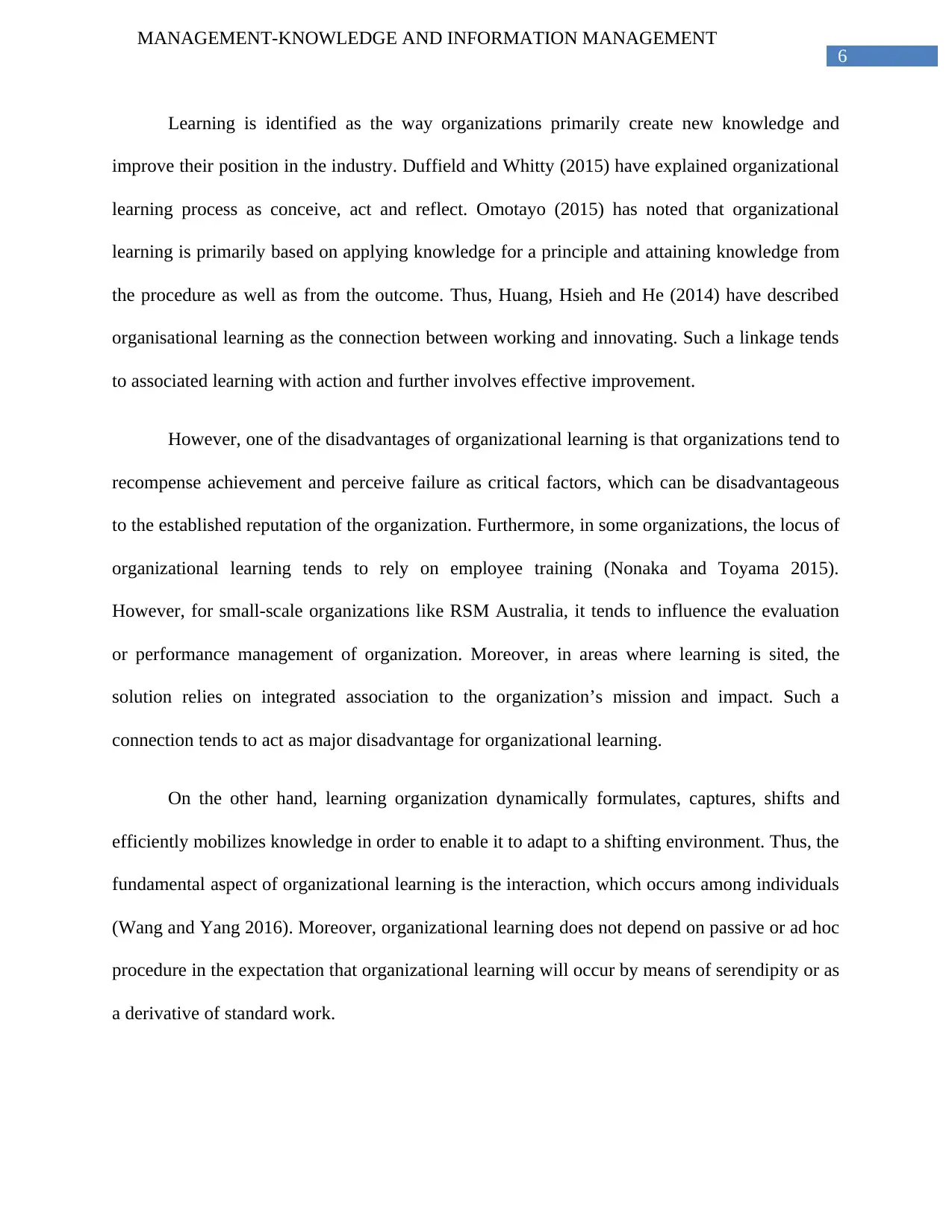
6
MANAGEMENT-KNOWLEDGE AND INFORMATION MANAGEMENT
Learning is identified as the way organizations primarily create new knowledge and
improve their position in the industry. Duffield and Whitty (2015) have explained organizational
learning process as conceive, act and reflect. Omotayo (2015) has noted that organizational
learning is primarily based on applying knowledge for a principle and attaining knowledge from
the procedure as well as from the outcome. Thus, Huang, Hsieh and He (2014) have described
organisational learning as the connection between working and innovating. Such a linkage tends
to associated learning with action and further involves effective improvement.
However, one of the disadvantages of organizational learning is that organizations tend to
recompense achievement and perceive failure as critical factors, which can be disadvantageous
to the established reputation of the organization. Furthermore, in some organizations, the locus of
organizational learning tends to rely on employee training (Nonaka and Toyama 2015).
However, for small-scale organizations like RSM Australia, it tends to influence the evaluation
or performance management of organization. Moreover, in areas where learning is sited, the
solution relies on integrated association to the organization’s mission and impact. Such a
connection tends to act as major disadvantage for organizational learning.
On the other hand, learning organization dynamically formulates, captures, shifts and
efficiently mobilizes knowledge in order to enable it to adapt to a shifting environment. Thus, the
fundamental aspect of organizational learning is the interaction, which occurs among individuals
(Wang and Yang 2016). Moreover, organizational learning does not depend on passive or ad hoc
procedure in the expectation that organizational learning will occur by means of serendipity or as
a derivative of standard work.
MANAGEMENT-KNOWLEDGE AND INFORMATION MANAGEMENT
Learning is identified as the way organizations primarily create new knowledge and
improve their position in the industry. Duffield and Whitty (2015) have explained organizational
learning process as conceive, act and reflect. Omotayo (2015) has noted that organizational
learning is primarily based on applying knowledge for a principle and attaining knowledge from
the procedure as well as from the outcome. Thus, Huang, Hsieh and He (2014) have described
organisational learning as the connection between working and innovating. Such a linkage tends
to associated learning with action and further involves effective improvement.
However, one of the disadvantages of organizational learning is that organizations tend to
recompense achievement and perceive failure as critical factors, which can be disadvantageous
to the established reputation of the organization. Furthermore, in some organizations, the locus of
organizational learning tends to rely on employee training (Nonaka and Toyama 2015).
However, for small-scale organizations like RSM Australia, it tends to influence the evaluation
or performance management of organization. Moreover, in areas where learning is sited, the
solution relies on integrated association to the organization’s mission and impact. Such a
connection tends to act as major disadvantage for organizational learning.
On the other hand, learning organization dynamically formulates, captures, shifts and
efficiently mobilizes knowledge in order to enable it to adapt to a shifting environment. Thus, the
fundamental aspect of organizational learning is the interaction, which occurs among individuals
(Wang and Yang 2016). Moreover, organizational learning does not depend on passive or ad hoc
procedure in the expectation that organizational learning will occur by means of serendipity or as
a derivative of standard work.
Paraphrase This Document
Need a fresh take? Get an instant paraphrase of this document with our AI Paraphraser
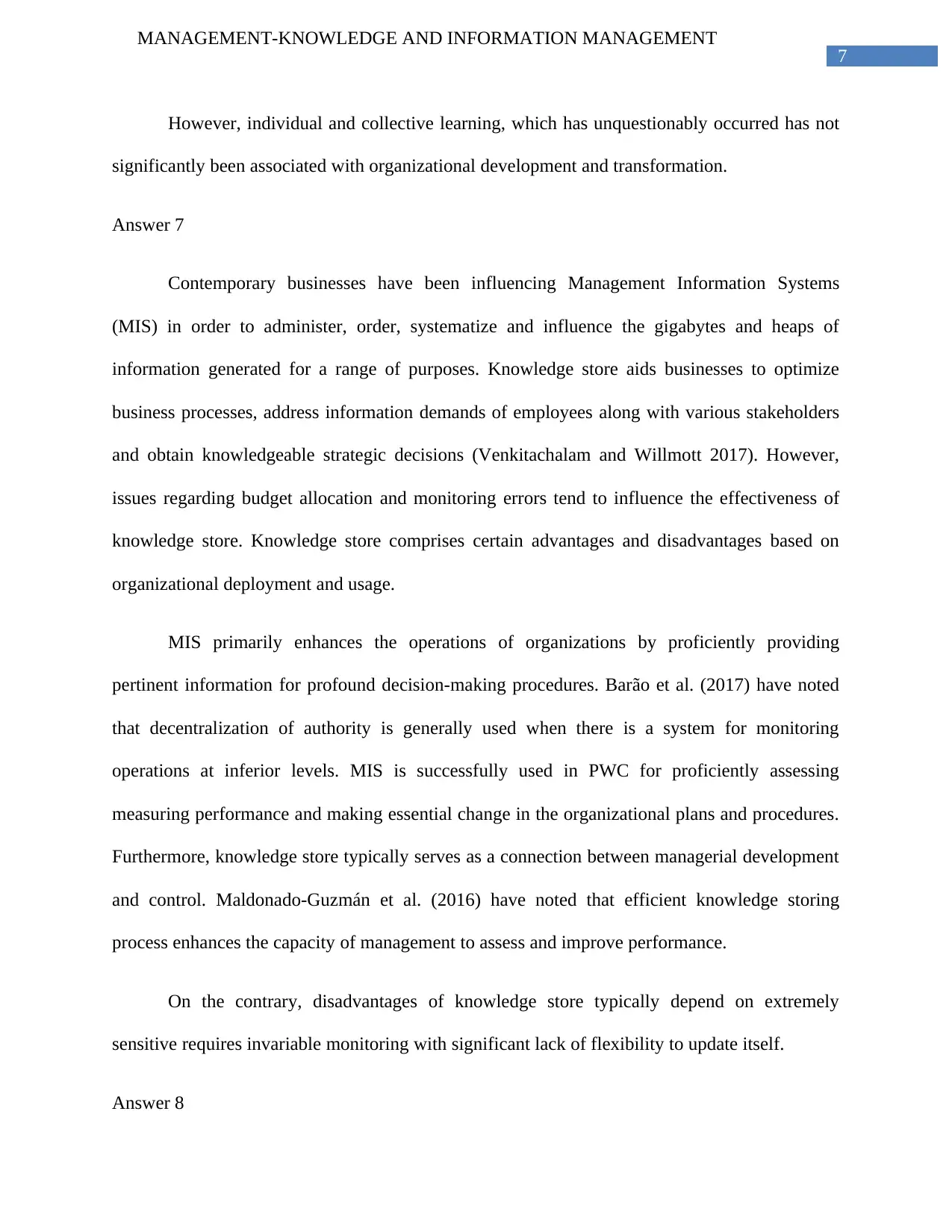
7
MANAGEMENT-KNOWLEDGE AND INFORMATION MANAGEMENT
However, individual and collective learning, which has unquestionably occurred has not
significantly been associated with organizational development and transformation.
Answer 7
Contemporary businesses have been influencing Management Information Systems
(MIS) in order to administer, order, systematize and influence the gigabytes and heaps of
information generated for a range of purposes. Knowledge store aids businesses to optimize
business processes, address information demands of employees along with various stakeholders
and obtain knowledgeable strategic decisions (Venkitachalam and Willmott 2017). However,
issues regarding budget allocation and monitoring errors tend to influence the effectiveness of
knowledge store. Knowledge store comprises certain advantages and disadvantages based on
organizational deployment and usage.
MIS primarily enhances the operations of organizations by proficiently providing
pertinent information for profound decision-making procedures. Barão et al. (2017) have noted
that decentralization of authority is generally used when there is a system for monitoring
operations at inferior levels. MIS is successfully used in PWC for proficiently assessing
measuring performance and making essential change in the organizational plans and procedures.
Furthermore, knowledge store typically serves as a connection between managerial development
and control. Maldonado-Guzmán et al. (2016) have noted that efficient knowledge storing
process enhances the capacity of management to assess and improve performance.
On the contrary, disadvantages of knowledge store typically depend on extremely
sensitive requires invariable monitoring with significant lack of flexibility to update itself.
Answer 8
MANAGEMENT-KNOWLEDGE AND INFORMATION MANAGEMENT
However, individual and collective learning, which has unquestionably occurred has not
significantly been associated with organizational development and transformation.
Answer 7
Contemporary businesses have been influencing Management Information Systems
(MIS) in order to administer, order, systematize and influence the gigabytes and heaps of
information generated for a range of purposes. Knowledge store aids businesses to optimize
business processes, address information demands of employees along with various stakeholders
and obtain knowledgeable strategic decisions (Venkitachalam and Willmott 2017). However,
issues regarding budget allocation and monitoring errors tend to influence the effectiveness of
knowledge store. Knowledge store comprises certain advantages and disadvantages based on
organizational deployment and usage.
MIS primarily enhances the operations of organizations by proficiently providing
pertinent information for profound decision-making procedures. Barão et al. (2017) have noted
that decentralization of authority is generally used when there is a system for monitoring
operations at inferior levels. MIS is successfully used in PWC for proficiently assessing
measuring performance and making essential change in the organizational plans and procedures.
Furthermore, knowledge store typically serves as a connection between managerial development
and control. Maldonado-Guzmán et al. (2016) have noted that efficient knowledge storing
process enhances the capacity of management to assess and improve performance.
On the contrary, disadvantages of knowledge store typically depend on extremely
sensitive requires invariable monitoring with significant lack of flexibility to update itself.
Answer 8
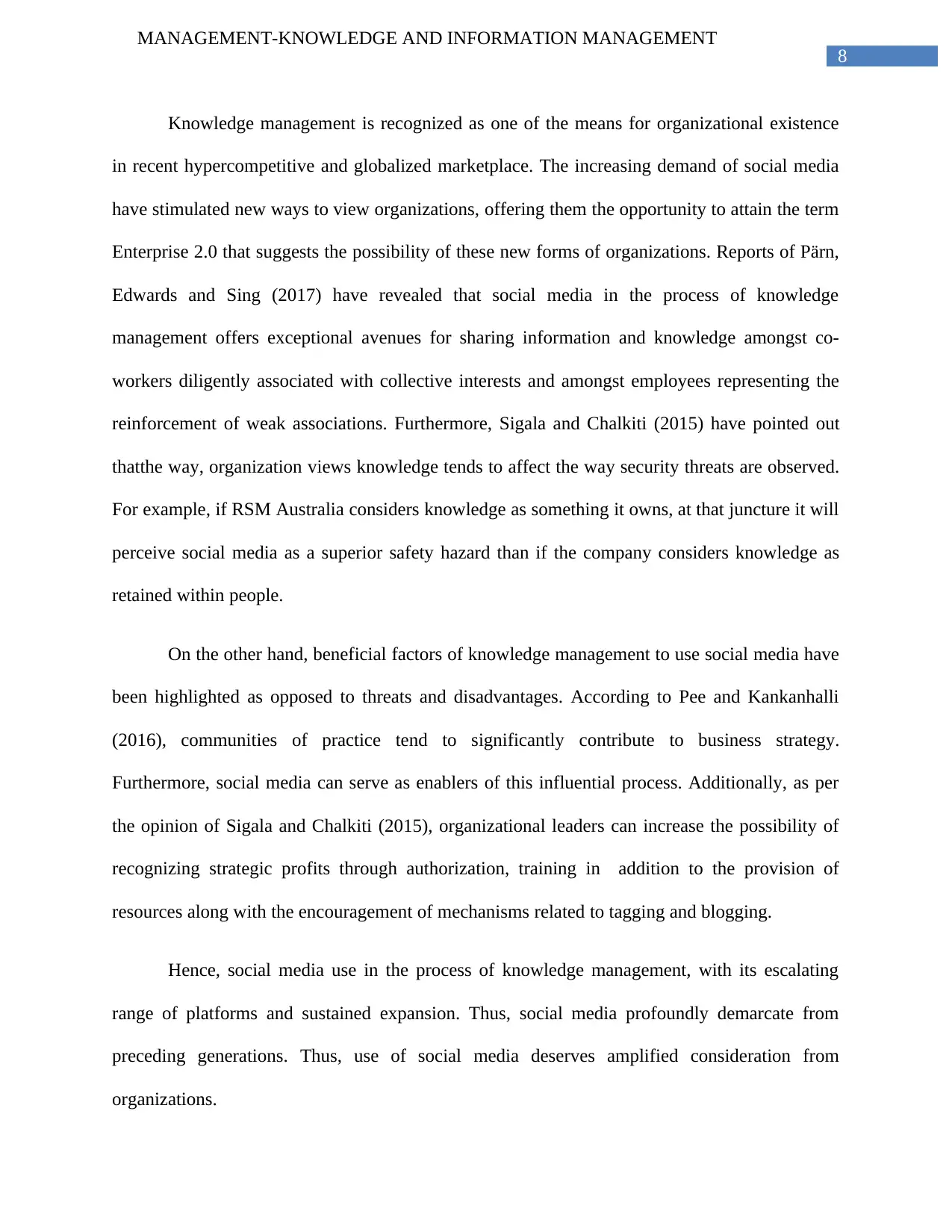
8
MANAGEMENT-KNOWLEDGE AND INFORMATION MANAGEMENT
Knowledge management is recognized as one of the means for organizational existence
in recent hypercompetitive and globalized marketplace. The increasing demand of social media
have stimulated new ways to view organizations, offering them the opportunity to attain the term
Enterprise 2.0 that suggests the possibility of these new forms of organizations. Reports of Pärn,
Edwards and Sing (2017) have revealed that social media in the process of knowledge
management offers exceptional avenues for sharing information and knowledge amongst co-
workers diligently associated with collective interests and amongst employees representing the
reinforcement of weak associations. Furthermore, Sigala and Chalkiti (2015) have pointed out
thatthe way, organization views knowledge tends to affect the way security threats are observed.
For example, if RSM Australia considers knowledge as something it owns, at that juncture it will
perceive social media as a superior safety hazard than if the company considers knowledge as
retained within people.
On the other hand, beneficial factors of knowledge management to use social media have
been highlighted as opposed to threats and disadvantages. According to Pee and Kankanhalli
(2016), communities of practice tend to significantly contribute to business strategy.
Furthermore, social media can serve as enablers of this influential process. Additionally, as per
the opinion of Sigala and Chalkiti (2015), organizational leaders can increase the possibility of
recognizing strategic profits through authorization, training in addition to the provision of
resources along with the encouragement of mechanisms related to tagging and blogging.
Hence, social media use in the process of knowledge management, with its escalating
range of platforms and sustained expansion. Thus, social media profoundly demarcate from
preceding generations. Thus, use of social media deserves amplified consideration from
organizations.
MANAGEMENT-KNOWLEDGE AND INFORMATION MANAGEMENT
Knowledge management is recognized as one of the means for organizational existence
in recent hypercompetitive and globalized marketplace. The increasing demand of social media
have stimulated new ways to view organizations, offering them the opportunity to attain the term
Enterprise 2.0 that suggests the possibility of these new forms of organizations. Reports of Pärn,
Edwards and Sing (2017) have revealed that social media in the process of knowledge
management offers exceptional avenues for sharing information and knowledge amongst co-
workers diligently associated with collective interests and amongst employees representing the
reinforcement of weak associations. Furthermore, Sigala and Chalkiti (2015) have pointed out
thatthe way, organization views knowledge tends to affect the way security threats are observed.
For example, if RSM Australia considers knowledge as something it owns, at that juncture it will
perceive social media as a superior safety hazard than if the company considers knowledge as
retained within people.
On the other hand, beneficial factors of knowledge management to use social media have
been highlighted as opposed to threats and disadvantages. According to Pee and Kankanhalli
(2016), communities of practice tend to significantly contribute to business strategy.
Furthermore, social media can serve as enablers of this influential process. Additionally, as per
the opinion of Sigala and Chalkiti (2015), organizational leaders can increase the possibility of
recognizing strategic profits through authorization, training in addition to the provision of
resources along with the encouragement of mechanisms related to tagging and blogging.
Hence, social media use in the process of knowledge management, with its escalating
range of platforms and sustained expansion. Thus, social media profoundly demarcate from
preceding generations. Thus, use of social media deserves amplified consideration from
organizations.

9
MANAGEMENT-KNOWLEDGE AND INFORMATION MANAGEMENT
References
Baldwin, C.Y. and Henkel, J., 2015. Modularity and intellectual property protection. Strategic
management journal, 36(11), pp.1637-1655.
Barão, A., de Vasconcelos, J.B., Rocha, Á. and Pereira, R., 2017. A knowledge management
approach to capture organizational learning networks. International Journal of Information
Management, 37(6), pp.735-740.
Charlesraj, V.P.C., 2014. Knowledge-based building information modeling (K-BIM) for
facilities management. In ISARC. Proceedings of the International Symposium on Automation
and Robotics in Construction (Vol. 31, p. 1). IAARC Publications.
Ding, L.Y., Zhong, B.T., Wu, S. and Luo, H.B., 2016. Construction risk knowledge management
in BIM using ontology and semantic web technology. Safety science, 87, pp.202-213.
Duffield, S. and Whitty, S.J., 2015. Developing a systemic lessons learned knowledge model for
organisational learning through projects. International journal of project management, 33(2),
pp.311-324.
Girard, J. and Girard, J., 2015. Defining knowledge management: Toward an applied
compendium. Online Journal of Applied Knowledge Management, 3(1), pp.1-20.
Huang, X., Hsieh, J.J. and He, W., 2014. Expertise dissimilarity and creativity: The contingent
roles of tacit and explicit knowledge sharing. Journal of Applied Psychology, 99(5), p.816.
MANAGEMENT-KNOWLEDGE AND INFORMATION MANAGEMENT
References
Baldwin, C.Y. and Henkel, J., 2015. Modularity and intellectual property protection. Strategic
management journal, 36(11), pp.1637-1655.
Barão, A., de Vasconcelos, J.B., Rocha, Á. and Pereira, R., 2017. A knowledge management
approach to capture organizational learning networks. International Journal of Information
Management, 37(6), pp.735-740.
Charlesraj, V.P.C., 2014. Knowledge-based building information modeling (K-BIM) for
facilities management. In ISARC. Proceedings of the International Symposium on Automation
and Robotics in Construction (Vol. 31, p. 1). IAARC Publications.
Ding, L.Y., Zhong, B.T., Wu, S. and Luo, H.B., 2016. Construction risk knowledge management
in BIM using ontology and semantic web technology. Safety science, 87, pp.202-213.
Duffield, S. and Whitty, S.J., 2015. Developing a systemic lessons learned knowledge model for
organisational learning through projects. International journal of project management, 33(2),
pp.311-324.
Girard, J. and Girard, J., 2015. Defining knowledge management: Toward an applied
compendium. Online Journal of Applied Knowledge Management, 3(1), pp.1-20.
Huang, X., Hsieh, J.J. and He, W., 2014. Expertise dissimilarity and creativity: The contingent
roles of tacit and explicit knowledge sharing. Journal of Applied Psychology, 99(5), p.816.
Secure Best Marks with AI Grader
Need help grading? Try our AI Grader for instant feedback on your assignments.

10
MANAGEMENT-KNOWLEDGE AND INFORMATION MANAGEMENT
Maldonado-Guzmán, G., Lopez-Torres, G.C., Garza-Reyes, J.A., Kumar, V. and Martinez-
Covarrubias, J.L., 2016. Knowledge management as intellectual property: evidence from
Mexican manufacturing SMEs. Management Research Review, 39(7), pp.830-850.
Nonaka, I. and Toyama, R., 2015. The knowledge-creating theory revisited: knowledge creation
as a synthesizing process. In The essentials of knowledge management (pp. 95-110). Palgrave
Macmillan, London.
Nowacki, R. and Bachnik, K., 2016. Innovations within knowledge management. Journal of
Business Research, 69(5), pp.1577-1581.
Omotayo, F.O., 2015. Knowledge Management as an important tool in Organisational
Management: A Review of Literature. Library Philosophy and Practice, 1(2015), pp.1-23.
Pärn, E.A., Edwards, D.J. and Sing, M.C.P., 2017. The building information modelling trajectory
in facilities management: A review. Automation in Construction, 75, pp.45-55.
Pee, L.G. and Kankanhalli, A., 2016. Interactions among factors influencing knowledge
management in public-sector organizations: A resource-based view. Government Information
Quarterly, 33(1), pp.188-199.
Sigala, M. and Chalkiti, K., 2015. Knowledge management, social media and employee
creativity. International Journal of Hospitality Management, 45, pp.44-58.
Venkitachalam, K. and Willmott, H., 2017. Strategic knowledge management—Insights and
pitfalls. International Journal of Information Management, 37(4), pp.313-316.
MANAGEMENT-KNOWLEDGE AND INFORMATION MANAGEMENT
Maldonado-Guzmán, G., Lopez-Torres, G.C., Garza-Reyes, J.A., Kumar, V. and Martinez-
Covarrubias, J.L., 2016. Knowledge management as intellectual property: evidence from
Mexican manufacturing SMEs. Management Research Review, 39(7), pp.830-850.
Nonaka, I. and Toyama, R., 2015. The knowledge-creating theory revisited: knowledge creation
as a synthesizing process. In The essentials of knowledge management (pp. 95-110). Palgrave
Macmillan, London.
Nowacki, R. and Bachnik, K., 2016. Innovations within knowledge management. Journal of
Business Research, 69(5), pp.1577-1581.
Omotayo, F.O., 2015. Knowledge Management as an important tool in Organisational
Management: A Review of Literature. Library Philosophy and Practice, 1(2015), pp.1-23.
Pärn, E.A., Edwards, D.J. and Sing, M.C.P., 2017. The building information modelling trajectory
in facilities management: A review. Automation in Construction, 75, pp.45-55.
Pee, L.G. and Kankanhalli, A., 2016. Interactions among factors influencing knowledge
management in public-sector organizations: A resource-based view. Government Information
Quarterly, 33(1), pp.188-199.
Sigala, M. and Chalkiti, K., 2015. Knowledge management, social media and employee
creativity. International Journal of Hospitality Management, 45, pp.44-58.
Venkitachalam, K. and Willmott, H., 2017. Strategic knowledge management—Insights and
pitfalls. International Journal of Information Management, 37(4), pp.313-316.
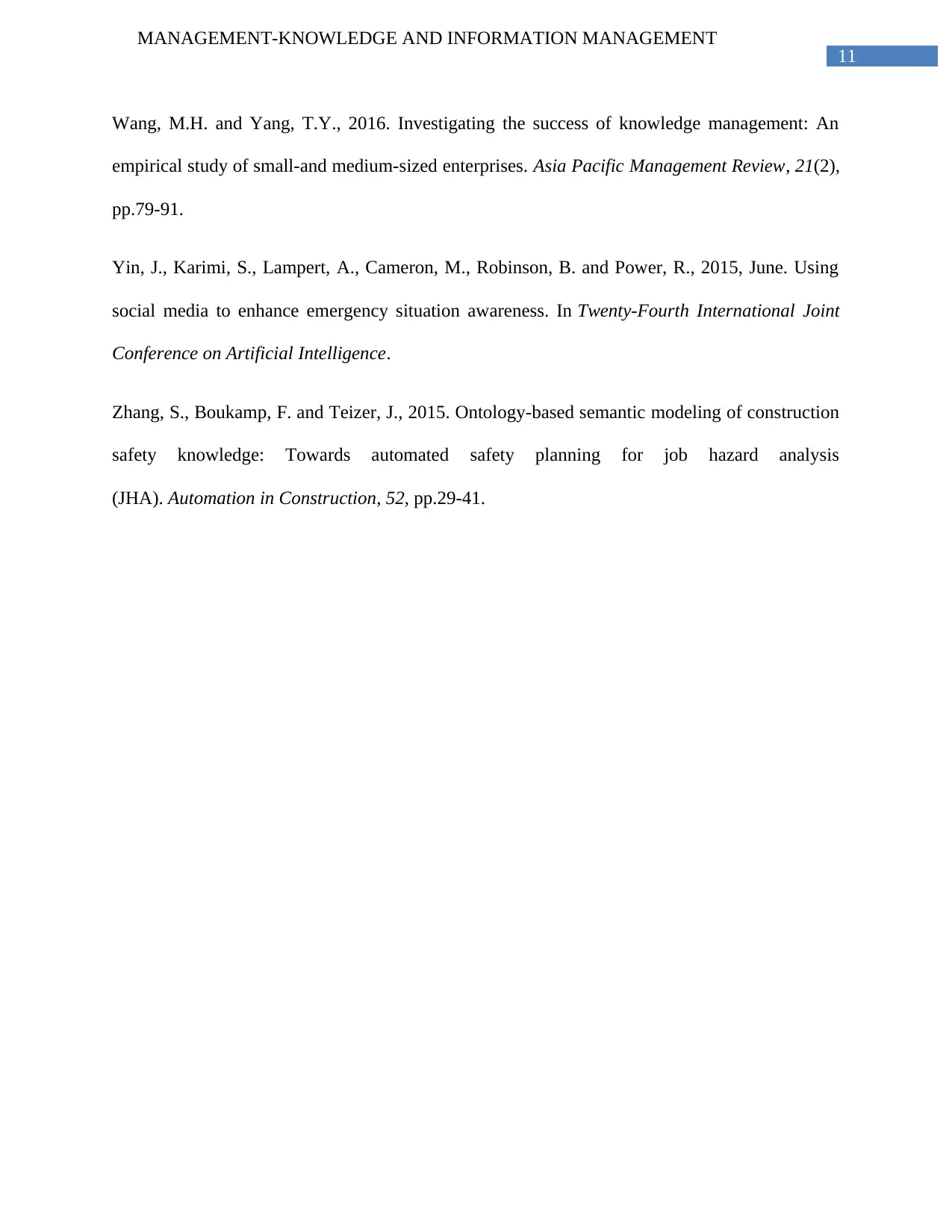
11
MANAGEMENT-KNOWLEDGE AND INFORMATION MANAGEMENT
Wang, M.H. and Yang, T.Y., 2016. Investigating the success of knowledge management: An
empirical study of small-and medium-sized enterprises. Asia Pacific Management Review, 21(2),
pp.79-91.
Yin, J., Karimi, S., Lampert, A., Cameron, M., Robinson, B. and Power, R., 2015, June. Using
social media to enhance emergency situation awareness. In Twenty-Fourth International Joint
Conference on Artificial Intelligence.
Zhang, S., Boukamp, F. and Teizer, J., 2015. Ontology-based semantic modeling of construction
safety knowledge: Towards automated safety planning for job hazard analysis
(JHA). Automation in Construction, 52, pp.29-41.
MANAGEMENT-KNOWLEDGE AND INFORMATION MANAGEMENT
Wang, M.H. and Yang, T.Y., 2016. Investigating the success of knowledge management: An
empirical study of small-and medium-sized enterprises. Asia Pacific Management Review, 21(2),
pp.79-91.
Yin, J., Karimi, S., Lampert, A., Cameron, M., Robinson, B. and Power, R., 2015, June. Using
social media to enhance emergency situation awareness. In Twenty-Fourth International Joint
Conference on Artificial Intelligence.
Zhang, S., Boukamp, F. and Teizer, J., 2015. Ontology-based semantic modeling of construction
safety knowledge: Towards automated safety planning for job hazard analysis
(JHA). Automation in Construction, 52, pp.29-41.
1 out of 12
Related Documents
Your All-in-One AI-Powered Toolkit for Academic Success.
+13062052269
info@desklib.com
Available 24*7 on WhatsApp / Email
![[object Object]](/_next/static/media/star-bottom.7253800d.svg)
Unlock your academic potential
© 2024 | Zucol Services PVT LTD | All rights reserved.





